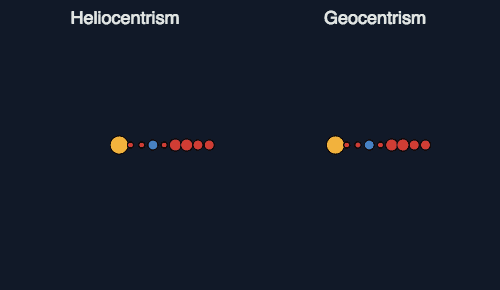I really love this beautiful animation of celestial mechanics by Malin Christersson. On the left-hand side, you see how simple and elegant it is to plot out celestial mechanics when you assume that all the planets in our solar system are in orbit around the sun. Whereas on the right you see Geocentrism.

Geocentrism is a belief that the Earth is the center of the universe and that all other celestial bodies revolve around it. This belief was widely held in ancient times and was supported by the apparent visual evidence that the sun, moon, and stars all seemed to move around the Earth.
Unfortunately, APIs are often relegated to middleware or plumbing. As such, they can be perceived as a cost/liability to an organization and not direct value to the business. In this scenario, APIs are often one-offs resulting in API sprawl, chaos and a high cost of ownership due to the difficulties in untangling the complexity created by multiple one-offs.
However, when you change the perspective and treat APIs as a product, you’ll end up with a beautiful heliocentric system of APIs: an organized foundation to fuel innovation and business results.
Dive Deeper into API Productization
Why treat APIs as products?
A product is any item or service you sell or provide to serve a customer’s need or want. The value of a product is determined by its ability to solve a problem or meet a need for your customer.
For examples of companies that treat APIs as product you can see that there are two main flavors of API products:
- APIs being sold directly as the product, i.e., Twilio for messaging or Stripe for payments
- APIs that contribute to your business goals. Walgreens pharmacy used APIs to open their services (including prescription fulfillment) to developers. Now, through these third-party healthcare apps, users can refill prescriptions.
From the outset you must have the business goals at heart: you need to meld technology and business together. But you must prioritize business goals first, technology second. This is what we truly mean when we discuss API productization.
Marty Cagan, author of “Inspired: How to Create Tech Products Customers Love,” highlights that a product should be feasible, usable, and valuable for the consumer. These concepts imply:
- Feasible: it makes sense for the company to build it from a financial, social, lucrative point of view, and the engineers can deliver it.
- Usable: the consumers can use it and it makes sense for them to implement it in their lives.
- Valuable: the product adds extra value to the life of the customers, a fact that makes them buy it.
You must have a vision for your API and how it will help to drive the business forward. When designing your API, you should adopt a product mindset. After all, the interface is intended for use by someone else.
Whether you sell it externally, or “sell” it to your internal developers, you have a product on your hands that is intended for use by someone else. As such, this product will have a lifecycle and success criteria.
With a product mindset, you will design and deliver the API to help drive business value. When you treat your API assets as products, you will evolve the API so that it in turn meets the evolving customer needs.
The API will have a lifecycle which matches that of a traditional software product. And the role of an API product manager will be identifying, planning, forecasting, production, and marketing of the API product at all stages of its lifecycle.
Treating your APIs as products also means evolving the API to provide the best consumer/developer experience. And there should be a single place for your consumers to view available assets regardless of their technical heritage (MFT, EDI, SOAP, REST, event-based, etc.)
Bas Van den Berg helps understand some of the distinctions between API product vs Product API in this video:
Watch the webinar replay to learn more about organizing APIs for business value.
Make it easy to consume your APIs with a marketplace
When it comes to treating APIs as products and eventually monetizing them, setting up an API marketplace is the next logical step.
The consuming developer doesn’t care about ‘how it works’; they care about ‘what it does and how it’s used.’ That’s why at Axway we have built Amplify Enterprise Marketplace, to make API consumption faster and easier.
The easiest way to think of an API marketplace is as a curated shopfront for your catalog of APIs and other integrations. API providers can publish APIs within this user-friendly hub and make them available for developers – both internal and external – to consume. This value exchange enables innovation on the part of shoppers and opportunities for revenue growth through monetization for providers.
With Amplify Marketplace, app developers don’t have to hunt around for the right API because it’s already packaged and neatly categorized in a central API marketplace. It allows businesses to meaningfully expand their ecosystem, accelerate development, and improve efficiency. In order to innovate fast, you must be able to integrate fast!
Good product management is all about building products that consumers love. Can you say that today about the APIs in your organization?
With a well-designed API, solid supporting documentation, and good support for developers’ existing tools, you will delight the technical consumers of your API every time. All this is available to you in Amplify Marketplace: it brings harmony to your solar system of APIs, and your ecosystem will run smoothly, just like the heliocentric solar system.
Learn 5 steps you can take now to drive API adoption.


